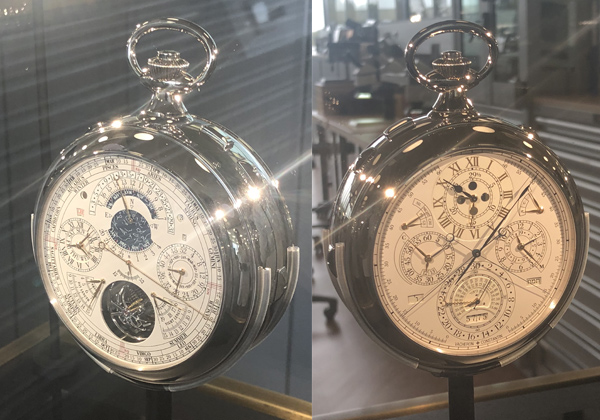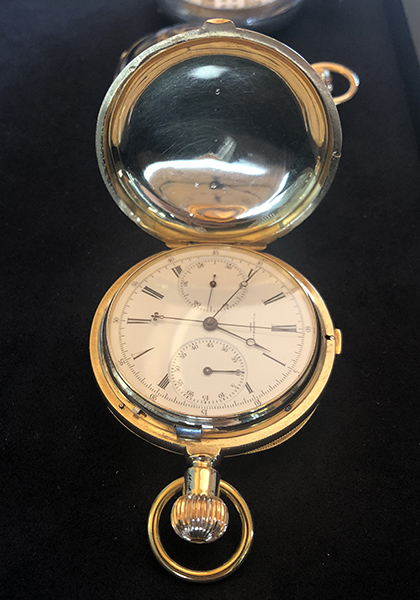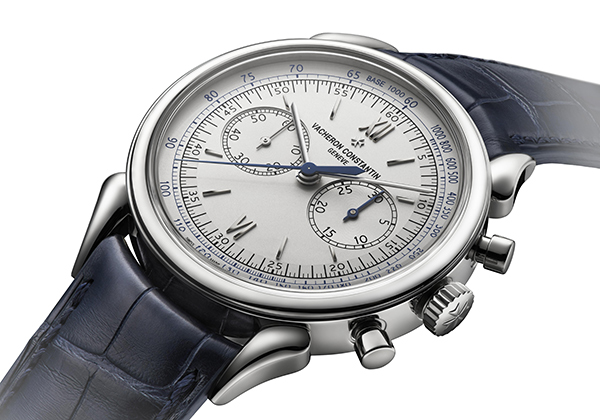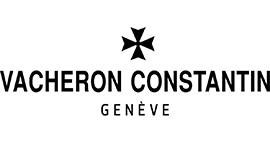Vacheron Constantin has earned a reputation for watch complications, but the watchmaker is particularly known for chronographs, which first emerged back in the 19th century. The Reference 57260, for example, was launched in 2015 to celebrate the watchmaker’s 260th anniversary. This one-of-a-kind piece features a unique double retrograde complication, and has more complications – 57 – than any watch in the world.

Chronograph movements were first implemented in pocket watches, and gradually moved to wristwatches such as the Cornes de Vache, which was updated in 2015.
The beginning
The chronograph was originally a development of the dead second. A chronograph complication which included an additional second hand that could start, stop and be reset to zero made its first appearance at Vacheron Constantin in a savonette watch dating back to 1874. In 1917, a major order was placed by the US Army to equip its engineering corps, who were involved in the European reconstruction effort. Many of these pieces had radium-filled luminescent markers.
The advent of the wristwatch
1917 was a landmark year for Vacheron Constantin, with the appearance of the first wrist-mounted chronograph. The practical and functional advantages of a wristwatch were clearly demonstrated in this first single-pusher model in gold, with a minute counter.

The 1930s and 1940s saw the release of the iconic references 4072 and 4178, which continue to fascinate collectors today. These two chronographs have a special place in Vacheron Constantin’s heritage, because they (along with the Cornes de Vache) played a key role in the company heritage, according to Christian Selmoni, director of style and heritage. He points out that the reference 4072 is even more significant in his eyes because of its longevity. “It was launched in the mid-1930s, and Vacheron Constantin continued to produce it right up to the late 1960s. This chronograph endured through four decades, which makes it a prime example of longevity. Its classic style remained relevant, independent of fashion,” notes Christian Selmoni.

Cornes de Vache: a chronograph par excellence
The 1950s brought a wind of change and originality to Vacheron Constantin, which has always prided itself on its innovative and trailblazing spirit. This decade marked the introduction of gadroons on the caseband, and the original Cornes de Vache or cow-horn-shaped lugs. In 1955, the reference 6087 “Cornes de Vache” (an in-house nickname that eventually entered general usage) in yellow and pinkgold was released in a run of just 36. This chronograph, which celebrated the watchmaker’s 200th anniversary, and which proved particularly popular on the American continent, was accompanied by two major improvements: water-resistance, and resistance to magnetic fields.

The end of the 1980s marked the big comeback of mechanical watches, and the rediscovery of complications such as the chronograph. The model 47001 (the first automatic movement) would be followed by a reissue of the model 4178 (hand-wound) and the reference 49005 (which had a perpetual calendar and moon phase display). The Overseas and Malte models came later.
2015 was an important year for the reference 6087, marking its first reissue since 1955. In terms of design, the updated model remains faithful to the original, although the addition of 3.5 mm to its diameter gives it a more modern appearance. Vacheron Constantin opted to equip it with the calibre 1142, developed in 1942 and with Poinçon de Genève certification, to remain as faithful as possible to the spirit of the original watch. “This is the chronograph we use in watches with a connection to the past, such as the Cornes de Vache,” explains Christian Selmoni. The 2015 edition in platinum was followed up with a version in 18K 4N pink gold in 2016.



This year, 2019, the watchmaker has unveiled the latest Historiques Cornes de Vache 1955 model in steel. It is driven by the 1142 calibre, which has the unique feature of a column wheel secured by screws with a Maltese cross head, the emblem of the Maison. It’s the first time this model has ever been produced in steel.

Strap by Serapian
To complete the Historiques Cornes de Vache 1955 in steel, Vacheron Constantin called upon the Milanese luxury leather goods manufacturer Serapian. Serapian has supplied a brown calf leather strap whose aged patina provides the perfect complement to timepiece’s vintage styling. The “attacco” shape of the second strap retainer is identical to those found on the Italian workshop’s handbag handles. The Historiques Cornes de Vache 1955 marks Vacheron Constantin’s first collaboration with Serapian.








